Fix: Logitech Wireless Mouse Not Working
When your Logitech wireless mouse stops working, it typically means the mouse is unresponsive, and no cursor movement is detected on your screen despite being connected. This issue can often be traced back to a failure in the connection between the mouse and its USB receiver, commonly caused by interference, a drained battery, or issues with the USB port or the receiver itself. Sometimes, software conflicts, such as driver issues or settings related to power management like USB autosuspend, can also be the culprits.
It’s important to ensure that your mouse is correctly paired with the receiver and that the drivers are up-to-date. Additionally, checking for physical obstructions or interference from other wireless devices can help resolve the problem
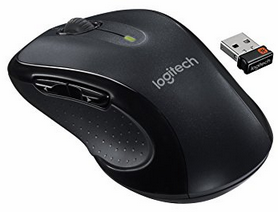
Solution 1: Remove the Batteries and Receiver
Sometimes all it takes for any device to get back in the correct configuration or behavior is a hard reset. In any hard reset, we take out all the components, including the source of power, and let the device discharge for a couple of minutes before plugging everything back in. This is an effective solution in this case and works for almost all users.
Remove the wireless receiver and the batteries present inside the mouse and wait for a couple of minutes. Let the mouse discharge completely before you plug everything back in. After inserting the battery and inserting the connector into a USB port, check if the problem is solved.
Solution 2: Replacing the Batteries
Logitech mice are known to have problems with batteries. Since they require a moderate amount of power to establish the connection with the wireless connector, they seem to drain more battery than average. Weak batteries might give the indication that the mouse is working correctly, but in reality, it wouldn’t be.
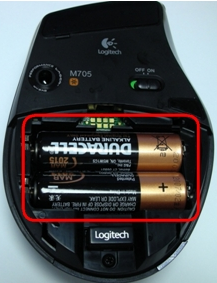
Replace the batteries but try to insert good high-quality batteries. Connect the batteries in the correct order and then try connecting the mouse again to the computer. Hopefully, the problem will be solved in no time.
Solution 3: Trying the Mouse on a Different Surface
The type of surface is essential for all mice to work as expected. In fact, there are lots of surfaces out there that don’t support the working of any mouse. Wood is a surface with a lot of diversity. A mouse might work on one wooden surface while it wouldn’t on another one. It all depends on the type of surface and which type of mouse you are using.
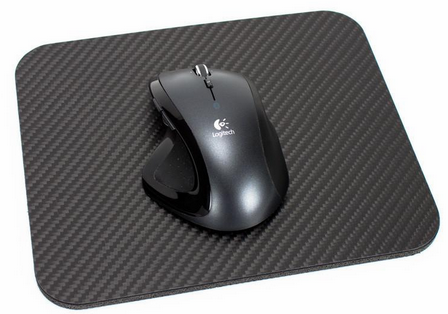
Try moving your laptop and check if the mouse works on other surfaces. In the case of a PC, you might bring other surfaces to you (such as paper or a mouse pad) and make sure that it isn’t the problem of a surface. A mouse pad is an ideal surface for the working of any mouse since it is designed that way.
Solution 4: Testing on Other USB Slots
The USB slot into which you are plugging the receiver might not be working as expected. It is not out of the blue if some USB ports don’t support the receiver while some of them do. Test the receiver on other USB slots. If you own a PC, try plugging the receiver into the slots present at the back side of the PC. In the case of a laptop, try plugging in all USB slots present on both sides of the computer.
Check the type of USB slots you are plugging the receiver into (2.0 or 3.0). If you are inserting the mouse into a type C slot with a USB converter, check if the USB converter is functioning properly without any discrepancies.
Solution 5: Checking the Mouse on Another Computer
If all the above methods don’t work, it is now time for you to test the mouse on another computer. It is possible that the drivers installed on your computer are not working as expected, causing the problems.
Try the mouse on another computer and see if it is working properly. Try inserting it into different USB ports and check there. Test all functionality of the mouse (including buttons) before you conclude any assumptions. If it is working perfectly on the other computer, it means there are probably driver problems on your computer. Continue with the other solutions.
Solution 6: Reinstalling the Default Drivers
If all the above solutions don’t prove successful, we can try installing the default drivers for your mouse. Drivers are the main driving force for any hardware. They connect the device and give exclusive control of it to the operating system. We will uninstall the drivers and restart the computer. Upon restart, the computer will install the default drivers back on your computer.
- Press Windows + R, type “devmgmt.msc” in the dialogue box and press Enter.
- Expand the category of “Mice and other pointing devices”. Locate the mouse, right-click it and select “Uninstall”.
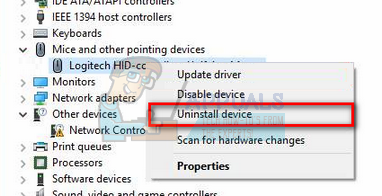
- Now restart your computer. Upon the restart, it will automatically detect the mouse and install the default drivers.
Solution 7: Updating Drivers
If installing the default drivers doesn’t prove to be a successful solution, you can try updating the drivers by either downloading them manually or through the automatic update. We will start with the automatic update and see if this solves the problem. If it doesn’t, we can move on to downloading the specific drivers from Logitech’s official website and installing them.
- Press Windows + R, type “devmgmt.msc” in the dialogue box and press Enter.
- Expand the category of “Mice and other pointing devices”. Locate the mouse, right-click it and select “Update Driver Software”.
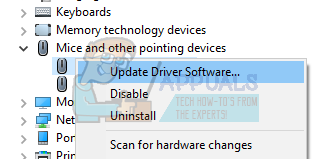
- Select the first option “Search automatically for updated driver software”. Windows will now search the internet for drivers for your model and install the most suitable one.
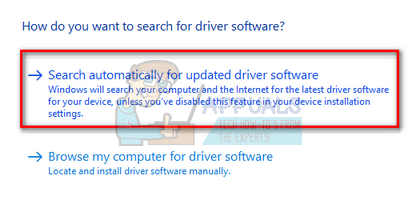
If the automatic installation doesn’t prove successful, you can head over to Logitech’s official website and download the drivers after inserting your model and build number. Save the driver to an accessible location.
- Navigate to the device manager as explained above and click on the option to update the mouse again.
- Select the second option “Browse my computer for driver software”. Navigate to the location where you installed the driver and install it accordingly.
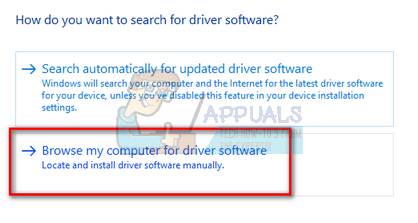
After the installation, check if the mouse is working correctly. If it isn’t, perform a hard reset and check again after restarting.